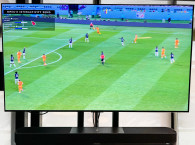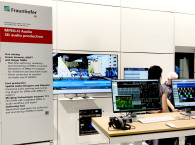
The MPEG-H TV Audio System, which is part of the ATSC 3.0 and DVB standards, was the first next-generation audio codec to go on the air as Korea chose it as the sole audio codec for its terrestrial UHD TV broadcasting system that launched in May 2017. The new TV experience is now available in the Seoul capital area, and will be extended to the metropolitan areas and the venue cities of the Olympic Games in Pyeongchang in 2018. By 2020, the service is scheduled to be available nationwide. Korean consumers can already purchase a growing number of MPEG-H enabled TVs from Samsung and LG today.
The MPEG-H TV Audio System makes a whole new auditory experience possible, enabling the viewer to be wrapped up in 3D immersive sound and to adjust the audio mix to their preference. With the MPEG-H TV Audio System, viewers have the ability to adjust their individual audio mix. For instance, they can change the balance between dialogue and background sounds or music, in order to improve speech intelligibility or put more emphasis on the stadium atmosphere in a sports broadcast. The choice between various commentators of a sporting event can also be enabled. Universal delivery ensures that the best sound is delivered regardless of the device, whether it’s a home theatre, smartphone or virtual reality device.
The advanced capabilities of the MPEG-H TV Audio System also allow for the transmission of streaming and television audio content with a cost-effective benefit for both broadcasters and streaming services. Immersive sound can be transmitted flexibly and highly efficiently with the MPEG-H TV Audio System. The data rates are similar to those used for surround sound. The supported audio formats are channels, objects and ambisonics which can be carried individually or combined inside a single audio bitstream with metadata.
The T12 is MStar’s mainstream UHD SOC platform. Supporting ATSC 3.0 and DVB T2/S2 in connection with HEVC and HDR, it is typically used for high to middle end television products. With the addition of the MPEG-H TV Audio System decoder, the MStar T12 becomes even more versatile and attractive in the UHD market. The MStar T12 SOC with MPEG-H TV Audio System decoding support is available immediately to interested manufacturers.

“The support of the MPEG-H TV Audio System in MStar’s T12 SOC is another huge step forward in providing solutions with next-generation audio features to the market. We are delighted to have worked with MStar Semiconductor on their adoption of the MPEG-H TV Audio System and look forward to continuing this collaboration in order to enable even more advanced products,” sates Harald Popp, head of the Business department at Fraunhofer IIS’ Audio and Media Technologies division.
“We are pleased to be partnering with Fraunhofer to realize a next generation audio codec on our UHD TV SOC platform. Leveraging our highly-integrated ICs, MPEG-H can fully bring an amazing experience for consumers. With Fraunhofer’s dedicated support, MStar will continue to contribute to the advancement of the TV industry,” says Sean Lin, Corporate VP, MStar.
www.iis.fraunhofer.de/tvaudio | www.mstarsemi.com






